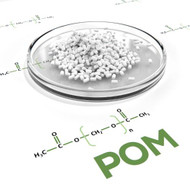POM: Low Friction, Dimensional Stability and Strength
History
Despite being discovered in 1859, polyoxymethylene (POM) remained confined to laboratory research due to the lack of knowledge regarding its potential uses. Extensive studies into POM, spanning over 50 years, began in the 1920s with Hermann Staudinger, a German chemist who received the 1953 Nobel Prize in Chemistry for his concept of macromolecules. His work involved the polymerization and structure of POM. Although his research was extensive and made significant advances, problems with thermostability prevented commercial production at that time.
In the 1950s, R.N. MacDonald at DuPont synthesized a high-molecular-weight version of POM that terminated in a hemiacetal, but it ultimately lacked the thermal stability needed for commercial viability. Later developments at DuPont, led by Dal Nogare, resulted in a thermostable, melt-processable plastic by reacting the hemiacetal ends of POM with acetic anhydride. This achievement led to the construction of a plant and the production of POM under the trade name Delrin in 1960. Although DuPont secured early patents and protection for the homopolymer structure, omitting the term "copolymer" in the patent allowed competitors to enter the market. Around the same time, Celanese completed its own research and partnered with the German firm Hoechst AG to produce a copolymer of POM under the trade name Celcon.
Quick Highlights
- Despite being discovered in 1959, polyoxymethylene (POM) remained confined to laboratory research until the 1950s due to the lack of knowledge regarding its potential uses and stability issues preventing commercialization.
- Following extensive research, chemists at DuPont secured early patents that allowed them to produce and commercialize Delrin, although omitting the term “copolymer” allowed their competitors Celanese and Hoechst AG to produce a copolymer of POM known as Celcon.
Properties
POM (also known as acetal, polyacetal, or polyformaldehyde) is a thermoplastic widely used in engineering due to its high stiffness, low friction, and excellent dimensional stability. The most common production processes for POM are injection molding and extrusion. Short-chain POMs, comprising 8 to 100 repeating units, are also called paraformaldehyde (PFA), while longer chains are typically referred to as POMs.
Quick Highlights
- POM, also known as acetal, polyacetal, or polyformaldehyde, is a high-performance thermoplastic widely used in engineering due to its excellent mechanical properties.
- Short-chain POMs between 8 and 100 units are referred to as paraformaldehyde (PFA), while longer chains are known as POMs.
Synthesized
For the production of POM homopolymer, anhydrous formaldehyde is required. This is obtained by reacting aqueous formaldehyde with an alcohol to form a hemiformal, which is subsequently dehydrated. Heating the mixture releases formaldehyde, which, in the presence of anionic catalysts, undergoes polymerization. The resulting polymer is then reacted with acetic anhydride to yield the final thermostable product. Large-diameter cross-sections may have pronounced centerline porosity due to the manufacturing process.
For POM copolymers, formaldehyde is converted into trioxane through acid catalysis using sulfuric acid or ion-exchange resins. Dioxolane is the standard comonomer, typically obtained from the reaction of ethylene glycol and aqueous formaldehyde under acid-catalyzed conditions. Alternatively, ethylene oxide can also be used as a comonomer. The polymerization reaction of trioxane and dioxolane is catalyzed by boron trifluoride etherate in a non-polar solvent or neat trioxane. Upon completion, the catalyst requires deactivation, and melting or solution hydrolysis is necessary to stabilize the polymer by removing unstable end groups. The polymer is then melt-compounded, and other stabilizers and fillers can be added. The main advantage of POM copolymers is their reduced propensity for depolymerization at normal processing temperatures. Various grades of POM copolymers are commercially available.
POM polymers have a highly crystalline structure, providing them with high strength and toughness. Their high strength-to-weight ratio has earned them the nickname “plastic steel”, as POMs can serve as suitable alternatives to certain metals due to their durability and mechanical properties.
Quick Highlights
- POM homopolymers are synthesized from anhydrous formaldehyde, which undergoes polymerization under anionic catalysis conditions. Finally, the resulting polymer is reacted with acetic anhydride to yield a stable end product.
- For POM copolymers, formaldehyde is converted to trioxane, which is subsequently reacted with a comonomer (typically dioxolane or ethylene oxide) in the presence of boron trifluoride etherate as a catalyst. Catalyst deactivation and melting/solution hydrolysis are required to yield a stable polymer.

Properties
PVC demonstrates good dimensional stability at ambient temperatures. However, its heat distortion and softening temperatures are low, and the melting process is challenging due to poor thermal stability and high-shear issues. Additionally, PVC has limited thermal stability above 140°C (284°F), as degradation causes the release of toxic fumes, including hydrogen chloride. Moreover, PVC becomes brittle at low temperatures.
Quick Highlights
- PVC has low heat distortion and softening temperatures and poor thermal stability above 140°C (284°F), with degradation releasing toxic fumes such as hydrogen chloride.
- Low temperatures are also problematic, as PVC becomes brittle and loses its mechanical properties.
Mechanical Properties
Exhibiting a high modulus of elasticity, POM demonstrates high stiffness and rigidity, making it an excellent material for applications that require shape retention under stress. Its excellent dimensional stability allows it to resist deformation under stress or load, as well as under varying temperatures. POM also has an intrinsically low friction coefficient, making it ideal for parts like gears, bearings, and sliders. The self-lubricating characteristic leads to a reduced need for additional lubrication and an enhanced lifespan. These properties allow the material to withstand repetitive mechanical action and wear without significant degradation. As such, this high-performance polymer finds applications in many sectors, including electrical, construction, automotive, mechanical, and biomedical industries.
Quick Highlights
- POM exhibits high stiffness, rigidity, and dimensional stability, allowing it to resist deformation under stress or load and varying temperatures.
- It has a low friction coefficient and self-lubricating properties, which reduce the need for additional lubrication and enhance its lifespan.
Thermal & Other Properties
POM demonstrates good thermal resistance between 40 °C and 120 °C (104 °F to 248 °F), with even higher temperatures being tolerated for limited exposure times. However, extreme temperatures may cause degradation and a loss of mechanical properties. POM also has low UV resistance, meaning prolonged exposure to sunlight may cause it to degrade. This weakness can be mitigated by using UV stabilizers added during manufacturing.
POM is an excellent electrical insulator and demonstrates low thermal conductivity, enabling its use in electronic and electrical parts. However, the buildup of heat generated from friction can be a concern and requires adequate management during design. The material is also flammable and produces toxic gases when burning, which may limit its applications. Fire retardants can be added to POM when applications require specific flammability standards.
Quick Highlights
- POM exhibits good thermal resistance between 40 °C and 120 °C (104 °F to 248 °F); short exposures to higher temperatures can also be tolerated. However, extreme temperatures may cause degradation and loss of mechanical properties.
- It has low UV resistance, which can be mitigated by the addition of UV stabilizers during manufacturing.
- POM is an excellent electrical insulator and exhibits low thermal conductivity, desirable properties in electronic or electric applications.
- This material is flammable and emits toxic gases during combustion, although fire retardants can be added during manufacturing to mitigate this weakness.
Sustainability
POM has a significant environmental impact due to the challenges associated with recycling. While its durability and extended lifespan reduce waste generation in certain applications, conventional recycling processes are unsuitable for POM, as POM releases toxic formaldehyde gas during combustion. As a result, the material often ends up in landfills, where it persists due to its non-biodegradable nature. Furthermore, the production process is energy-intensive, contributing to its carbon footprint. Although research is underway to improve its recyclability, current practices remain limited.
Quick Highlights
- POM has a significant carbon footprint due to the energy-intensive production process, nonbiodegradability, and limited recycling practices as combustion releases toxic formaldehyde gas.
- While its durability and extended lifespan reduce waste generation in certain applications, and research is underway to improve POM’s recyclability, enhanced energy and waste management could also help limit the environmental impact.
POM (Polyoxymethylene) plastic bolts are known for their strength, stiffness, and low friction, making them ideal for structural and mechanical applications. Available in white hex head styles and M12 to M16 sizes, these durable fasteners are suited for engineering use where metal alternatives are too heavy or conductive.





